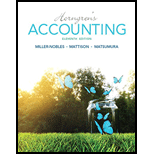
Concept explainers
Concept Introduction:
Periodic Inventory System: The periodic inventory system records and updates the inventory at the end of a particular period. The inventory balance is not updated after each transaction and it is updated periodically.
FIFO method: FIFO Stands for First In First Out. Under this method, the units purchased first are assumed to be sold first and cost of goods sold is calculated accordingly. The ending inventory in the method includes the latest units purchased.
LIFO method: LIFO Stands for Last In First Out. Under this method, the latest units purchased are assumed to be sold first and cost of goods sold is calculated accordingly. The ending inventory in the method includes the oldest units purchased.
Weighted Average method: Under this method, the cost per unit of the inventory is calculated as weighted average cost per unit and the cost of goods sold and inventory is calculated with the help of weighted average cost per unit.
Requirement-1:
To Determine: The Ending Merchandise inventory and Cost of Goods sold amount using the FIFO method under Periodic inventory system
Want to see the full answer?
Check out a sample textbook solution
Chapter 6 Solutions
Horngren's Accounting (11th Edition)
- I need help finding the accurate solution to this general accounting problem with valid methods.arrow_forwardCan you help me solve this general accounting problem with the correct methodology?arrow_forwardKindly help me with this General accounting questions not use chart gpt please fast given solutionarrow_forward
- Please given correct answer for General accounting question I need step by step explanationarrow_forwardCan you solve this general accounting problem with appropriate steps and explanations?arrow_forwardPlease explain the solution to this general accounting problem with accurate explanations.arrow_forward
- Patricia receives $65,000 worth of Nextech, Inc., common stock from her uncle's estate. Early in the year, she receives a $320 cash dividend. Three months later, she received a 3% stock dividend. Near the end of the year, Patricia sells the stock for $68,500. Due to these events only, how much must Patricia include in her gross income for the year?arrow_forwardI am searching for the correct answer to this general accounting problem with proper accounting rules.arrow_forwardGriffin Manufacturing has provided the following data for the month of March. The balance in the Finished Goods inventory account at the beginning of the month was $95,200 and at the end of the month was $89,600. The cost of goods manufactured for the month was $428,300. The actual manufacturing overhead cost incurred was $142,700 and the manufacturing overhead cost applied to jobs was $146,500. The adjusted cost of goods sold that would appear on the income statement for March is __.arrow_forward

 AccountingAccountingISBN:9781337272094Author:WARREN, Carl S., Reeve, James M., Duchac, Jonathan E.Publisher:Cengage Learning,
AccountingAccountingISBN:9781337272094Author:WARREN, Carl S., Reeve, James M., Duchac, Jonathan E.Publisher:Cengage Learning, Accounting Information SystemsAccountingISBN:9781337619202Author:Hall, James A.Publisher:Cengage Learning,
Accounting Information SystemsAccountingISBN:9781337619202Author:Hall, James A.Publisher:Cengage Learning, Horngren's Cost Accounting: A Managerial Emphasis...AccountingISBN:9780134475585Author:Srikant M. Datar, Madhav V. RajanPublisher:PEARSON
Horngren's Cost Accounting: A Managerial Emphasis...AccountingISBN:9780134475585Author:Srikant M. Datar, Madhav V. RajanPublisher:PEARSON Intermediate AccountingAccountingISBN:9781259722660Author:J. David Spiceland, Mark W. Nelson, Wayne M ThomasPublisher:McGraw-Hill Education
Intermediate AccountingAccountingISBN:9781259722660Author:J. David Spiceland, Mark W. Nelson, Wayne M ThomasPublisher:McGraw-Hill Education Financial and Managerial AccountingAccountingISBN:9781259726705Author:John J Wild, Ken W. Shaw, Barbara Chiappetta Fundamental Accounting PrinciplesPublisher:McGraw-Hill Education
Financial and Managerial AccountingAccountingISBN:9781259726705Author:John J Wild, Ken W. Shaw, Barbara Chiappetta Fundamental Accounting PrinciplesPublisher:McGraw-Hill Education





